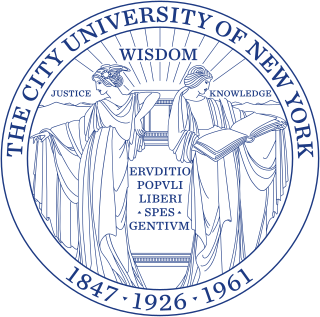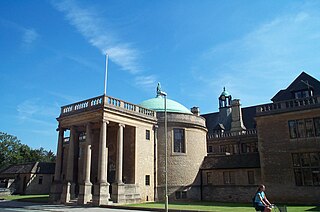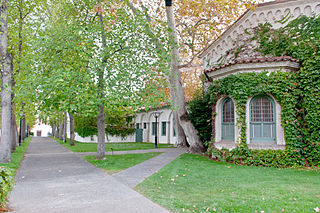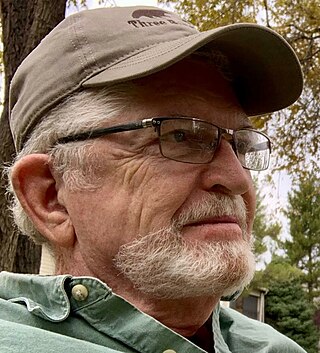
Barnard College, officially titled as Barnard College, Columbia University, is a private women's liberal arts college in the borough of Manhattan in New York City. It was founded in 1889 by a group of women led by young student activist Annie Nathan Meyer, who petitioned Columbia University's trustees to create an affiliated college named after Columbia's then-recently deceased 10th president, Frederick A.P. Barnard. The college is one of the original Seven Sisters—seven liberal arts colleges in the Northeastern United States that were historically women's colleges.

The City University of New York is the public university system of New York City. It is the largest urban university system in the United States, comprising 25 campuses: eleven senior colleges, seven community colleges, and seven professional institutions. In 1960, John R. Everett became the first chancellor of the Municipal College System of New York City, later known as the City University of New York (CUNY). CUNY, established by New York State legislation in 1961 and signed into law by Governor Nelson Rockefeller, was an amalgamation of existing institutions and a new graduate school.

Oberlin College is a private liberal arts college and conservatory of music in Oberlin, Ohio, United States. Founded in 1833, it is the oldest coeducational liberal arts college in the United States and the second-oldest continuously operating coeducational institute of higher learning in the world. The Oberlin Conservatory of Music is the oldest continuously operating conservatory in the United States. In 1835, Oberlin became one of the first colleges in the United States to admit African Americans, and in 1837, the first to admit women. It has been known since its founding for progressive student activism.

Occidental College is a private liberal arts college in Los Angeles, California. Founded in 1887 as a coeducational college by clergy and members of the Presbyterian Church, it became non-sectarian in 1910. It is one of the oldest liberal arts colleges on the West Coast of the United States.

The Rhodes Scholarship is an international postgraduate award for students to study at the University of Oxford in Oxford, United Kingdom.

Morehouse College is a private historically Black, men's, liberal arts college in Atlanta, Georgia. Anchored by its main campus of 61 acres (25 ha) near Downtown Atlanta, the college has a variety of residential dorms and academic buildings east of Ashview Heights. Along with Spelman College, Clark Atlanta University, and the Morehouse School of Medicine, the college is a member of the Atlanta University Center consortium.

Howard University is a private, federally chartered historically black research university in Washington, D.C., located in the Shaw neighborhood. It is classified among "R2: Doctoral Universities – High research activity" and accredited by the Middle States Commission on Higher Education.

Rhodes College is a private liberal arts college in Memphis, Tennessee. Historically affiliated with the Presbyterian Church (USA), it is a member of the Associated Colleges of the South and is accredited by the Southern Association of Colleges and Schools. Rhodes enrolls about 2,000 students, and its Collegiate Gothic campus sits on a 123-acre wooded site in Memphis' historic Midtown neighborhood.

Virginia Intermont College (VI) was a private college in Bristol, Virginia. Founded in 1884 to create additional educational opportunities for women, the college had been coeducational since 1972. It experienced significant financial difficulties during the last years of its existence, was denied accreditation in 2013, and announced its closure on May 20, 2014.
The Telluride Association is a non-profit organization in the United States founded in 1910 by Lucien Lucius Nunn and named for his hometown, Telluride, Colorado. The organization states its mission as providing young people with free educational programs emphasizing intellectual curiosity, democratic self-governance, and social responsibility.

Wilson College is a private, Presbyterian-related college in Chambersburg, Pennsylvania. Founded in 1869 by two Presbyterian ministers, it was named for its first major donor, Sarah Wilson of nearby St. Thomas Township, Pennsylvania, who gave $30,000 toward the purchase of the land and home of Alexander McClure.

Lucien Lucius Nunn was an American entrepreneur and educator who founded the Telluride House, Telluride Association and Deep Springs College. He received his higher education at Oberlin College and studied law at Harvard Law School.

Women's colleges in the United States are private single-sex U.S. institutions of higher education that only admit female students. They are often liberal arts colleges. There are approximately 26 active women's colleges in the United States in 2024, down from a peak of 281 such colleges in the 1960s.
The Webb School is a private coeducational college preparatory boarding and day school in Bell Buckle, Tennessee, founded in 1870. It has been called the oldest continuously operating boarding school in the South. Under founder Sawney Webb's leadership, the school produced more Rhodes Scholars than any other secondary school in the United States.

Barbara Warne Newell is an economist, career professor, and higher education administrator. Notably, she served as the tenth President of Wellesley College from 1972 to 1980 and was the first female chancellor of the State University System of Florida from 1981 to 1985.

Virginia Beatrice Smith was an American lawyer, economist, educator, and eighth president of Vassar College. Smith is the namesake of the Virginia B. Smith Innovative Leadership Award of the Council for Adult and Experiential Learning and the National Center for Public Policy and Higher Education.
John W. Olmsted (1903–1986) was an American Rhodes scholar and historian of early modern Europe. He taught history at University of California, Los Angeles for 24 years and served as faculty representative to the Pacific Coast Conference for seven years. He also served as the first chairman of University of California, Riverside's Humanities Division.

The Telluride House, formally the Cornell Branch of the Telluride Association (CBTA), and commonly referred to as just "Telluride", is a highly selective residential community of Cornell University students and faculty. Founded in 1910 by American industrialist L. L. Nunn, the house grants room and board scholarships to a number of undergraduate and graduate students, post-doctoral researchers and faculty members affiliated with the university's various colleges and programs. A fully residential intellectual society, the Telluride House takes as its pillars democratic self-governance, communal living and intellectual inquiry. Students granted the house's scholarship are known as Telluride Scholars.
A manual labor college was a type of school in the United States, primarily between 1825 and 1860, in which work, usually agricultural or mechanical, supplemented academic activity.

L. Jackson Newell is an American historian and philosopher of higher education, specializing in the study and leadership of progressive colleges from Antioch College and Berea College prior to the Civil War through the new wave taking root in the early 2020s, including Outer Coast College, Thoreau College, and the Tidelines Institute. He has served as professor of educational leadership and dean of Liberal Education at the University of Utah, and as president of Deep Springs College.



















